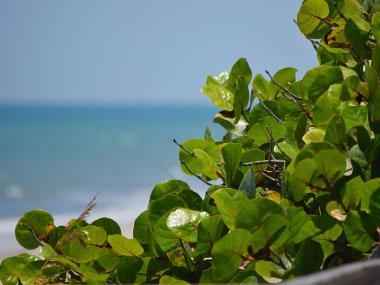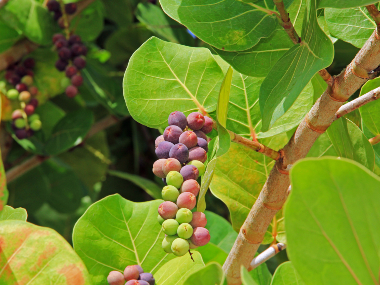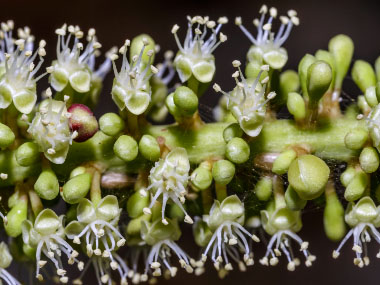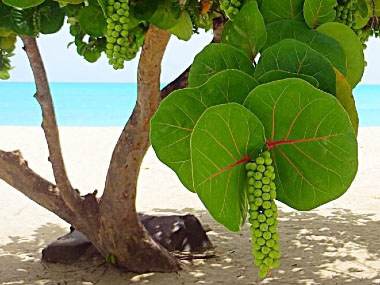






To support our efforts please browse our store (books with medicinal info, etc.).
Seaside grapes, also known as sea grapes, are an evergreen shrub (or small tree) with roundish, red-veined leaves; spikes of whitish flowers; and edible, reddish fruits which hang in grape-like clusters. Seaside grape tends to branch close to the ground. A common seaside shrub, this grows in many countries and has been commonly used for furniture. The bark resin was and continues to be used against throat ailments. Seaside grapes are a member of the buckwheat family (Polygonaceae). Other names include Baygrape, Platterleaf, Shore Grape, and Raisin Marine. The genus name Coccoloba derives from the Greek word kokkolobis, a kind of grape. The specific epithet uvifera derives from Latin, meaning 'fruiting in clusters, resembling grapes'.
Trunk/Bark
The bark is thin, and it can have several trunks. Bark is light brown.
Branches/Twigs
Stems commonly have swollen nodes. They can be brownish to somewhat orange-like.
Height
Although the height can greatly vary, it averages between 7 and 9 metres (25 to 30’). In some locations, such as South America, it can grow to 14 metres (50’) but it spreads out as opposed to growing higher. This shrub, when cultivated, grows higher like a tree if it is regularly pruned; in the wild, it will get to a certain height then sprawl outward.
Leaves/Needles
Seaside grape leaves grow alternate and are orbiculate (round). The shiny, leathery, green leaf blade can grow 20 to 30 cm (8 to 12”) long with a cordate leaf base. Leaf veins are pinnate, some having a reddish tinge. The margin is entire (smooth).
Flowers
Seaside grape has small fragrant white flowers that are arranged in spike inflorescences. These measure 15 to 25 cm (6 to 8”) long.
Fruit
Round, berry-like fruits that measure 2 cm (0.75”) wide are tightly packed in long hanging clusters. There are usually more than 40 fruits in each cluster.
Habitat
This shrub grows throughout tropical regions of the world. It is native to Florida, Bahamas, West Indies, Mexico, and South America. When growing directly along a coastline, it has a sprawling growth. Coastal environments tend to be windy, and the soil is typically drier and lacks nutrients. These conditions cause the seaside grape shrub to be smaller. This shrub is grown in some (tropical) gardens.
Edible Parts
Ripe fruit is edible and is commonly used to make jams, jellies, and wine. Leaves are used to make tea.
Other Name
Sea Grapes.
Recipes
Winter Survival Food Handbook

PDF Plant Magazines
Types of Wild Food
Geographic Zones Seasons
Disclaimer
EdibleWildFood.com is informational in nature. While we strive to be 100% accurate, it is solely up to the reader to ensure proper plant identification. Some wild plants are poisonous or can have serious adverse health effects.
We are not health professionals, medical doctors, nor are we nutritionists. It is up to the reader to verify nutritional information and health benefits with qualified professionals for all edible plants listed in this web site. Please click here for more information.
Why Edible Wild Food?
- Food costs are rising
- Free, wild food is readily abundant
- Wild food adds nutrition to your diet
- Wild food can help treat various medical conditions





